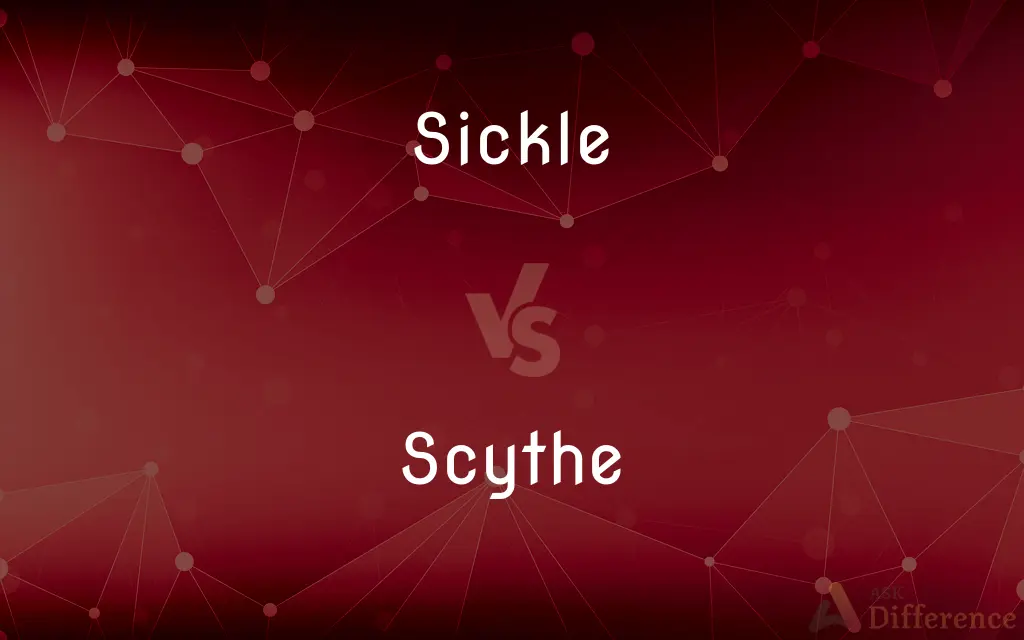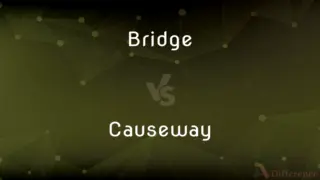Sickle vs. Scythe — What's the Difference?
By Fiza Rafique — Updated on September 10, 2023
A sickle is a short-handled farming tool with a semicircular blade, used for cutting crops. A scythe is a long-handled tool with a long, curved blade used for cutting grass or reaping crops.

Difference Between Sickle and Scythe
Table of Contents
ADVERTISEMENT
Key Differences
A sickle is a handheld agricultural tool featuring a curved blade that is used mainly for harvesting crops like wheat, barley, and rice. A scythe, on the other hand, has a longer handle and a longer, broader blade and is also used for agricultural purposes, mainly mowing grass and reaping crops. Both tools have blades that are sharp and curved, but their designs and uses differ significantly.
The sickle is usually used with one hand and is effective for cutting individual stalks of grain or for trimming. The scythe, in contrast, requires a two-handed grip and is swung in a wide arc to cut larger areas of vegetation, such as fields of grass. Both are ancient tools, dating back thousands of years, but the scythe is generally more efficient for larger tasks due to its design.
The blade of a sickle is typically semicircular and shorter, making it more suitable for precise, close-range work. The blade of a scythe is longer, often straighter, and attached at an angle to the handle, which makes it effective for sweeping cuts across a field. Both tools are made from materials like steel for the blade and wood or metal for the handle.
While both the sickle and the scythe are used in farming, their specialized designs make them more effective for certain tasks. The sickle is often employed in tight spaces where maneuverability is required. The scythe is more suited for open fields where large swaths of vegetation need to be cut efficiently. Both are iconic symbols often associated with harvesting.
Comparison Chart
Handle Length
Short
Long
ADVERTISEMENT
Blade Shape
Semicircular
Long, curved
Number of Hands
One-hand
Two-hand
Typical Use
Cutting crops
Mowing grass, reaping crops
Symbolism
Harvest
Harvest, Grim Reaper
Compare with Definitions
Sickle
A handheld agricultural tool with a curved blade for harvesting crops.
He used the sickle to cut the wheat stalks.
Scythe
A long-handled agricultural tool with a curved blade for mowing grass or reaping crops.
He swung the scythe to clear the field of tall grass.
Sickle
A symbol commonly associated with communist ideologies.
The hammer and sickle represent the union of industrial and agricultural workers.
Scythe
A cutting instrument designed for sweeping motions across large areas.
The scythe efficiently cut down the whole row of wheat.
Sickle
A cutting instrument used in small-scale gardening.
She grabbed a sickle to trim the overgrown bushes.
Scythe
A historical farming implement used for tasks requiring a long reach.
Farmers of old relied on the scythe for harvesting.
Sickle
An ancient implement used historically across various cultures for farming.
The sickle has been used in agriculture for thousands of years.
Scythe
A two-handed tool optimized for ergonomic efficiency during long working hours.
The design of the scythe minimizes back strain during extended use.
Sickle
A short-handled tool often used for precise cutting in tight spaces.
The sickle was perfect for cutting the tall weeds near the fence.
Scythe
A scythe is an agricultural hand tool for mowing grass or harvesting crops. It is traditionally used to cut down or reap edible grains, before the process of threshing.
Sickle
A sickle, bagging hook, reaping-hook or grasshook is a single-handed agricultural tool designed with variously curved blades and typically used for harvesting, or reaping, grain crops or cutting succulent forage chiefly for feeding livestock, either freshly cut or dried as hay. Falx was a synonym but was later used to mean any of a number of tools that had a curved blade that was sharp on the inside edge such as a scythe.
Scythe
A tool used for cutting crops such as grass or corn, with a long curved blade at the end of a long pole attached to one or two short handles.
Sickle
A short-handled farming tool with a semicircular blade, used for cutting corn, lopping, or trimming.
Scythe
Cut with a scythe
The grass was scythed at regular intervals
You may want hardy infantry troops to scythe down the opposition
The first job was to scythe paths through the nettles
Sickle
An implement having a crescent-shaped blade attached to a short handle, used for cutting grain or tall grass.
Scythe
An implement consisting of a long, curved single-edged blade with a long handle, used for mowing or reaping.
Sickle
The cutting mechanism of a reaper or mower.
Scythe
To cut with or as if with a scythe.
Sickle
To cut with a sickle.
Scythe
An instrument for mowing grass, grain, etc. by hand, composed of a long, curving blade with a sharp concave edge, fastened to a long handle called a snath.
Sickle
To deform (a red blood cell) into an abnormal crescent shape.
Scythe
(historical) A scythe-shaped blade attached to ancient war chariots.
Sickle
To assume an abnormal crescent shape. Used of red blood cells.
Scythe
(cartomancy) The tenth Lenormand card.
Sickle
Shaped like the blade of a sickle; crescent-shaped
A sickle moon.
Scythe
(intransitive) To use a scythe.
Sickle
(agriculture) An implement having a semicircular blade and short handle, used for cutting long grass and cereal crops.
Scythe
(transitive) To cut with a scythe.
Sickle
Any of the sickle-shaped middle feathers of the domestic cock.
Scythe
(transitive) To cut off as with a scythe; to mow.
Sickle
To cut with a sickle.
Scythe
To attack or injure as if cutting.
Sickle
(transitive) To deform (as with a red blood cell) into an abnormal crescent shape.
Scythe
An instrument for mowing grass, grain, or the like, by hand, composed of a long, curving blade, with a sharp edge, made fast to a long handle, called a snath, which is bent into a form convenient for use.
The sharp-edged scythe shears up the spiring grass.
Whatever thingThe scythe of Time mows down.
Sickle
(intransitive) Of red blood cells: to assume an abnormal crescent shape.
Scythe
A scythe-shaped blade attached to ancient war chariots.
Sickle
Shaped like the blade of a sickle; crescent-shaped.
A sickle moon
Scythe
To cut with a scythe; to cut off as with a scythe; to mow.
Time had not scythed all that youth begun.
Sickle
A reaping instrument consisting of a steel blade curved into the form of a hook, and having a handle fitted on a tang. The sickle has one side of the blade notched, so as always to sharpen with a serrated edge. Cf. Reaping hook, under Reap.
When corn has once felt the sickle, it has no more benefit from the sunshine.
Scythe
An edge tool for cutting grass; has a long handle that must be held with both hands and a curved blade that moves parallel to the ground
Sickle
A group of stars in the constellation Leo. See Illust. of Leo.
Scythe
Cut with a scythe;
Scythe grass or grain
Sickle
An edge tool for cutting grass or crops; has a curved blade and a short handle
Common Curiosities
What is a sickle used for?
It's primarily used for harvesting crops like wheat and rice.
Which requires two hands, a sickle or a scythe?
A scythe requires two hands, while a sickle can be operated with one.
What is a scythe used for?
It's mainly used for mowing grass and reaping larger fields of crops.
Is a sickle the same as a scythe?
No, a sickle has a short handle and a short blade, while a scythe has a long handle and a long blade.
What is the shape of a scythe blade?
The blade of a scythe is long and curved, often almost straight.
What is the handle length difference between a sickle and a scythe?
A sickle has a short handle, while a scythe has a long handle.
Is the blade of a sickle straight or curved?
The blade of a sickle is usually curved or semicircular.
Are sickles and scythes still used today?
Yes, they are still used, particularly in regions where mechanized farming is less common.
Is a sickle effective for large fields?
Generally, no. A sickle is more suited for smaller, more precise tasks.
How old are these tools?
Both sickles and scythes are ancient tools, dating back thousands of years.
Is a scythe efficient for cutting individual stalks?
No, a scythe is more effective for cutting large swaths of vegetation.
Is a scythe ergonomic?
The design of a scythe aims to minimize back strain and is optimized for long hours of work.
What materials are sickles and scythes made of?
Blades are generally made of steel, while handles can be made of wood or metal.
Can a sickle be used for gardening?
Yes, it can be used for small-scale gardening tasks like trimming.
Share Your Discovery

Previous Comparison
Bridge vs. Causeway
Next Comparison
Solicit vs. ElicitAuthor Spotlight
Written by
Fiza RafiqueFiza Rafique is a skilled content writer at AskDifference.com, where she meticulously refines and enhances written pieces. Drawing from her vast editorial expertise, Fiza ensures clarity, accuracy, and precision in every article. Passionate about language, she continually seeks to elevate the quality of content for readers worldwide.
















































